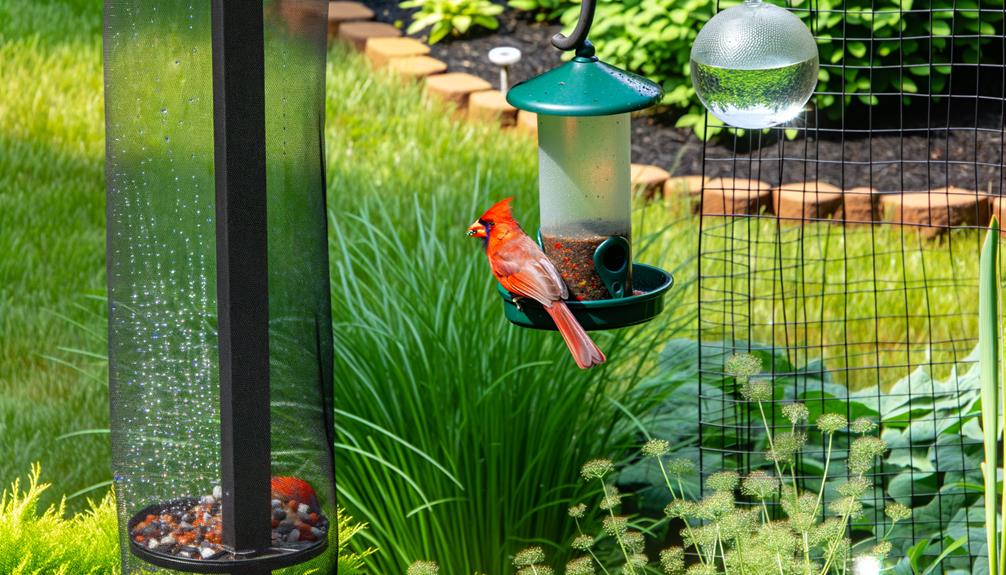Humane Methods to Get Rid of a Male Cardinal from Your Yard
To get rid of a male cardinal, understand its territorial behavior. Apply decals or bird-safe tape to your windows, spaced 2-4 inches apart, to reduce reflections and aggressive performances.
Reposition bird feeders away from reflective surfaces and use feeds that discourage cardinals, promoting a diverse ecosystem. Decoys and auditory deterrents like distress calls can effectively divert and unsettle the bird.
Modify the habitat by removing food sources and pruning nesting sites, ensuring these changes don't harm other wildlife. There are several more strategies that can be learned to manage their presence ethically and efficiently.

Key Takeaways
- Apply bird-safe decals or non-reflective films on windows to reduce aggressive behaviors caused by reflections.
- Place bird feeders away from windows to minimize territorial aggression and reflection-induced stress.
- Use realistic cardinal decoys and reflective objects like CDs to divert the bird's focus and discourage lingering.
- Implement auditory deterrents, such as distress call recordings, to create an unsettling environment for the male cardinal.
- Modify the habitat by removing food sources, nesting materials, and shelter, ensuring it remains balanced and diverse for other wildlife.
Understand Cardinal Behavior
To effectively address the presence of a male cardinal, you need to understand its territorial instincts and behavioral patterns. Male cardinals are highly territorial during the breeding season, often defending their area vigorously. You'll notice them engaging in repetitive behaviors like singing loudly from prominent perches or attacking perceived intruders, including their reflections.
Observing these patterns helps you predict their movements and responses. Ethical considerations require you to manage this without causing harm. Avoid any actions that could stress or injure the bird. Understanding their need for territory allows you to devise non-lethal strategies to redirect their focus.
This knowledge forms the basis for humane interventions, ensuring both your peace and the cardinal's well-being.
Modify Windows and Reflective Surfaces
Given the male cardinal's tendency to attack its reflection, applying decals or bird-safe tape to your windows can greatly reduce these aggressive behaviors. These visual markers disrupt the bird's perception of another male, thereby reducing territorial aggression.
Decals should be spaced closely, ideally 2-4 inches apart, to effectively break up reflections. Alternatively, you can install external screens or use non-reflective window films. For ethical considerations, ensure these adjustments don't harm the bird or obstruct your view excessively.
Observations indicate that adjusting reflective surfaces notably decreases window strikes and stress-induced behaviors in cardinals. Using these scientifically-backed methods helps create a safer environment for both the bird and your household, promoting coexistence without harm.
Manage Bird Feeders Effectively
Managing bird feeders effectively begins with strategically placing them away from windows and reflective surfaces to minimize territorial aggression in male cardinals. Observing their behavior, you'll notice that they often mistake reflections for rival males. Ensuring feeders are in open areas reduces these confrontations. Additionally, adjust the type of feed to discourage cardinals while attracting other birds.
| Feed Type | Bird Species Attracted |
|---|---|
| Black Oil Sunflower | Cardinals, Finches |
| Safflower | Finches, Chickadees |
| Nyjer (Thistle) | Goldfinches, Pine Siskins |
| Cracked Corn | Sparrows, Mourning Doves |
| Mixed Seed | Various Small Birds |
Ethically managing your bird feeders promotes a peaceful environment, preventing undue stress on male cardinals while maintaining a diverse avian ecosystem.
Utilize Decoys and Deterrents
Strategically deploying visual decoys and auditory deterrents can effectively reduce male cardinal aggression by creating perceived competition or disturbances in their territory. Place realistic cardinal decoys in areas where the male cardinal is most active. These decoys simulate rival presence, diverting the bird's focus away from your space.
Additionally, employ reflective objects like hanging CDs or specialized bird deterrent tape. These create visual disturbances, discouraging the cardinal from lingering.
Auditory deterrents, such as distress call recordings, can also be effective. Play these sounds intermittently to create an unsettling environment for the male cardinal.
Always make sure your methods are humane and don't cause harm to the bird. Ethical considerations are paramount to responsibly managing wildlife interactions.
Create a Less Attractive Habitat
To further discourage the presence of a male cardinal, modify the habitat to make it less appealing by removing food sources and nesting materials. Examine your garden for readily available seeds, fruits, or insects that cardinals favor. Prune dense shrubs and trees where they might nest, and clear away any potential nesting materials like leaves and twigs.
| Habitat Element | Action |
|---|---|
| Food Sources | Eliminate bird feeders and fallen fruits. |
| Nesting Materials | Remove leaves, twigs, and branches. |
| Shelter | Trim dense shrubs and cut lower branches. |
Ethically, verify these modifications don't negatively impact other wildlife. Make detailed observations to confirm the changes decrease cardinal activity while maintaining a balanced ecosystem. Your goal is to create a less appealing but still naturally diverse habitat.
Conclusion
By understanding cardinal behavior, modifying reflective surfaces, managing feeders, utilizing deterrents, and creating a less attractive habitat, you can effectively address the presence of a male cardinal. Isn't it fascinating how small changes can make a big difference?
Always prioritize ethical considerations, ensuring the bird's well-being while implementing these strategies.
Through detailed observations and scientifically-sound methods, you'll foster a harmonious environment that respects both your space and the cardinal's natural instincts.





